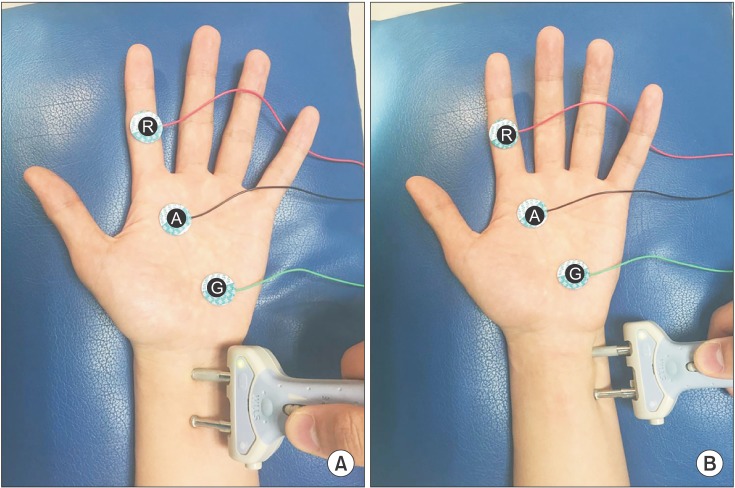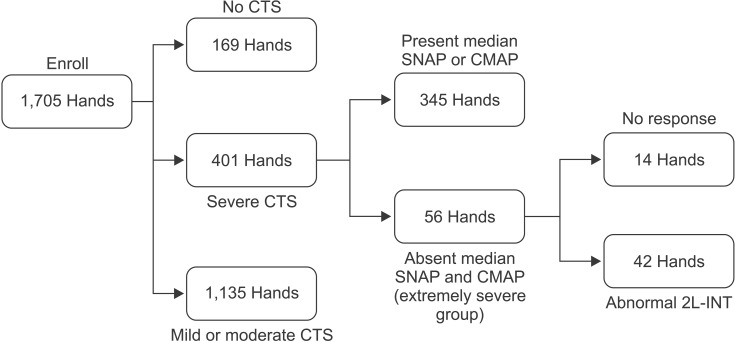Ann Rehabil Med.
2016 Feb;40(1):50-55. 10.5535/arm.2016.40.1.50.
Diagnostic Value of the Second Lumbrical-Interosseous Distal Motor Latency Comparison Test in Severe Carpal Tunnel Syndrome
- Affiliations
-
- 1Department of Rehabilitation Medicine, Hallym University Kangdong Sacred Heart Hospital, Hallym University College of Medicine, Seoul, Korea. don@hallym.or.kr
- KMID: 2155165
- DOI: http://doi.org/10.5535/arm.2016.40.1.50
Abstract
OBJECTIVE
To examine the usefulness of the second lumbrical-interosseous (2L-INT) distal motor latency (DML) comparison test in localizing median neuropathy to the wrist in patients with absent median sensory and motor response in routine nerve conduction studies.
METHODS
Electrodiagnostic results from 1,705 hands of patients with carpal tunnel syndrome (CTS) symptoms were reviewed retrospectively. All subjects were evaluated using routine nerve conduction studies: median sensory conduction recorded from digits 1 to 4, motor conduction from the abductor pollicis brevis muscle, and the 2L-INT DML comparison test.
RESULTS
Four hundred and one hands from a total of 1,705 were classified as having severe CTS. Among the severe CTS group, 56 hands (14.0%) showed absent median sensory and motor response in a routine nerve conduction study, and, of those hands, 42 (75.0%) showed an abnormal 2L-INT response.
CONCLUSION
The 2L-INT DML comparison test proved to be a valuable electrodiagnostic technique in localizing median mononeuropathy at the wrist, even in the most severe CTS patients.
Keyword
MeSH Terms
Figure
Reference
-
1. Lee HJ, Kwon HK, Kim DH, Pyun SB. Nerve conduction studies of median motor nerve and median sensory branches according to the severity of carpal tunnel syndrome. Ann Rehabil Med. 2013; 37:254–262. PMID: 23705122.
Article2. Preston DC, Logigian EL. Lumbrical and interossei recording in carpal tunnel syndrome. Muscle Nerve. 1992; 15:1253–1257. PMID: 1488062.
Article3. Park DS, Nam HS, Kim DH, Choi EH, Jun AY, Lee SE. Diagnostic usefulness of the second lumbrical and interosseous recording in severe carpal tunnel syndrome. J Korean Assoc EMG Electrodiagn Med. 2009; 11:73–77.4. Boonyapisit K, Katirji B, Shapiro BE, Preston DC. Lumbrical and interossei recording in severe carpal tunnel syndrome. Muscle Nerve. 2002; 25:102–105. PMID: 11754192.
Article5. Brannegan R, Bartt R. Second lumbrical muscle recordings improve localization in severe carpal tunnel syndrome. Arch Phys Med Rehabil. 2007; 88:259–261. PMID: 17270527.
Article6. Inukai T, Uchida K, Kubota C, Takamura T, Nakajima H, Baba H. Additional method for diagnosis of carpal tunnel syndrome: value of the second lumbricalinterossei test (2L-INT). Hand Surg. 2013; 18:49–52. PMID: 23413850.
Article7. Meena AK, Srinivasa Rao B, Sailaja S, Mallikarjuna M, Borgohain R. Second lumbrical and interossei latency difference in carpal tunnel syndrome. Clin Neurophysiol. 2008; 119:2789–2794. PMID: 18986835.
Article8. Ahn MK, Kim SJ. Diagnostic value of median-ulnar motor difference recorded on lumbrical and interosseous in carpal tunnel syndrome. J Korean Acad Rehabil Med. 1994; 18:35–44.9. Dumitru D, Zwarts MJ. Nerve conduction studies. In : Dumitru D, Amato AA, Zwarts M, editors. Electrodiagnostic medicine. 2nd ed. Philadelphia: Hanley & Belfus;2002. p. 159–223.10. Padua L, Lo Monaco M, Padua R, Gregori B, Tonali P. Neurophysiological classification of carpal tunnel syndrome: assessment of 600 symptomatic hands. Ital J Neurol Sci. 1997; 18:145–150. PMID: 9241561.
Article11. Loscher WN, Auer-Grumbach M, Trinka E, Ladurner G, Hartung HP. Comparison of second lumbrical and interosseous latencies with standard measures of median nerve function across the carpal tunnel: a prospective study of 450 hands. J Neurol. 2000; 247:530–534. PMID: 10993495.12. Kaul MP, Pagel KJ. Median sensory nonresponders in carpal tunnel syndrome workup. Arch Phys Med Rehabil. 2002; 83:1120–1122. PMID: 12161834.
Article13. Yates SK, Yaworski R, Brown WF. Relative preservation of lumbrical versus thenar motor fibres in neurogenic disorders. J Neurol Neurosurg Psychiatry. 1981; 44:768–774. PMID: 6273508.
Article14. Sunderland S. The intraneural topography of the radial, median and ulnar nerves. Brain. 1945; 68:243–299. PMID: 20982793.
Article15. Planitzer U, Steinke H, Meixensberger J, Bechmann I, Hammer N, Winkler D. Median nerve fascicular anatomy as a basis for distal neural prostheses. Ann Anat. 2014; 196:144–149. PMID: 24374103.
Article
- Full Text Links
- Actions
-
Cited
- CITED
-
- Close
- Share
- Similar articles
-
- The Carpal compression Test for Diagnosing Carpal Tunnel Syndrome
- Sensitivity of Multi-electrodiagnostic Parameters in Carpal Tunnel Syndrome: Usefulness of residual latency
- Therapeutic Effect of Local Steroid Injection in the Carpal Tunnel Syndrome: Clinical and Electrophysiologic Evaluation
- Reappraisal of Nerve Conduction Studies in Carpal Tunnel Syndrome
- Electrodiagnostic Methods for Carpal Tunnel Syndrome Combined with Diabetic Polyneuropathy




